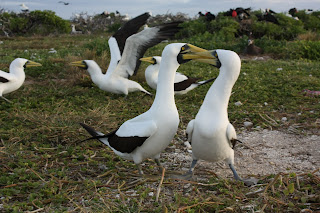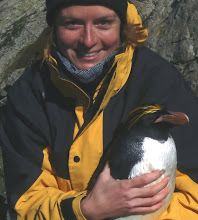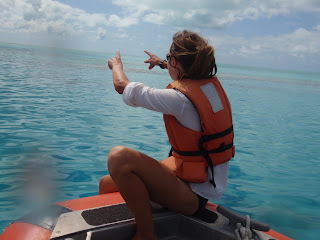It is very hard not to make smutty double entendres when you are dealing with boobies, and this is perhaps why masked boobies are so angry all the time. When you've just heard someone say "Look at that lovely pair of boobies!" and snigger for the 50th time you are bound to be a little cheesed off.
Masked boobies are the angriest birds of all time ever and breeding season brings out the worst in them. Around mid January the masked boobies start to pair off and stake out a little piece of ground on which they will lay their eggs. This patch is jealously guarded against all other creatures, particularly by the female boobies who are much louder and bossier than the males. If an unwary albatross ventures too close to the boobies' special area, the female starts honking loudly and indignantly at it, then will usually charge, causing the albatross to run away in terror. Unwary humans get the same treatment. The males, meanwhile, seem a little embarrased by this behaviour and will sheepishly bring up the rear producing nothing more than a faint asthmatic whistle. Border skirmishes between neighbouring pairs of masked boobies are frequent. These usually begin with two pairs of boobies facing off across the edge of their territory, the females shrieking at each other and the males whistling at each other. This squabbling quickly descends into outright violence, sometimes with other masked boobies joining in just for the hell of it. After a few minutes of vicious beak-wrestling everyone backs down and retreats a little, though still screaming insults at each other. It's a bit like the end of 'Wife Swap', when the two couples finally meet face to face.
 If looks could kill- a masked booby.
If looks could kill- a masked booby. Trouble brewing.
Trouble brewing. Trouble.
Trouble.Masked boobies are another species that have dispensed with all that silly nest building nonsense and lay their eggs directly on the ground. Despite this, and perhaps in response to some ancestral impulse, the male masked booby will try to impress his wife by bringing her bits of nesting material. The female sits in the middle of the nesting area looking annoyed while the male runs around picking up tiny bits of twig or tiny pebbles and setting them down very, very gently and carefully in front of her. The females seem largely unimpressed by this activity, though they do sometimes pick up the tiny twigs and tiny pebbles and place them behind or to the side of themselves in a kind of nest building mime.
After a month or so of brutal fighting and delicate pebble moving, the female masked booby produces two white eggs. Life is tough for masked boobies right from the get-go. One egg hatches first, then when the second egg hatches the smaller chick is ejected from the nest and dies, so that it's older sibling will get all the food and attention. Thus the masked boobies have a kind of grim insurance policy- if one egg fails to hatch or gets broken, they have the other as a back up. If both hatch then the second chick becomes superfluous.
 Mr. and Mrs. Masked Booby. The male (on the left) has yellower feet and bill.
Mr. and Mrs. Masked Booby. The male (on the left) has yellower feet and bill. A masked booby nest. Woe betide anyone who sets foot inside the circle.
A masked booby nest. Woe betide anyone who sets foot inside the circle. Baby booby.
Baby booby. They grow up so fast.
They grow up so fast. Warning: do not attempt to cuddle.
Warning: do not attempt to cuddle.Red-footed boobies also breed on Tern Island, and they are like the relaxed hippie cousins of the masked boobies. They are smaller, calmer and much less likely to rip your face off if you look at them funny. They build nests in the bushes like real birds and only lay one egg at a time, so there is no need for any of that messy infanticide. Red-foots pay the price for being Mr. Nice Booby though, and are constantly harrassed by their arch-nemesis, the frigatebirds, who steal their food and twigs.
 A red-footed booby displaying.
A red-footed booby displaying. Male red-foots have a greener bill than females.
Male red-foots have a greener bill than females. Coming in to land.
Coming in to land. A chip off the old block.
A chip off the old block.One of the projects I have been helping out with is putting satellite tags on both masked and red-footed boobies to find out which areas of the ocean they feed in. This involves a certain amount of grabbing masked boobies. Although they are smaller than albatross, they are extremely strong and have a bill like a vice, and their disposition is less than sunny as I have already mentioned. Grabbing boobies is therefore a little bit more daunting than grabbing albatross. On top of this, boobies have no external nostrils, so when holding them you have to keep their mouth open at all times but tucking your index finger in there. Heavily reinforced leather gloves and safety goggles are useful accessories for this task.
How to catch a masked booby.1. Approach the booby, trying to appear nonchalent.
2. Once within striking distance of the razor-sharp bill, hold out your hand as 'bait'.
3. The booby will lunge at your hand and start trying to remove your fingers. It is important not to panic at this point.
4. With your free arm move the booby away from its eggs, gather up the wings and try to gain control of the bill before your hand is reduced to a bloody pulp.
 Protective clothing is required for catching masked boobies.
Protective clothing is required for catching masked boobies. Tagging a red-foot.
Tagging a red-foot. The satellite tag is attached to the booby's tail.
The satellite tag is attached to the booby's tail. Caitie and Sarah take some booby vital statistics.
Caitie and Sarah take some booby vital statistics.
 Ruth and Melinda flash their boobies for the camera.
Ruth and Melinda flash their boobies for the camera. Relaxing red-foots.
Relaxing red-foots. That hard to reach itch.
That hard to reach itch.






















































